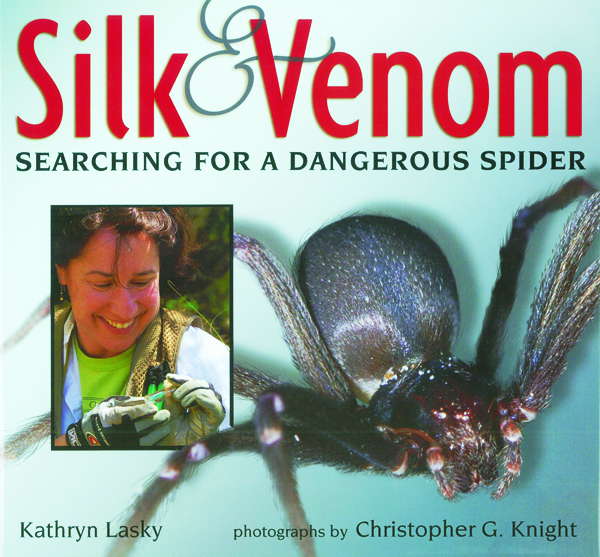Hunting Spiders
Candlewick, 2011. 64 pages. $13. Purchase here.
Open gallery

Greta Binford, associate professor of biology, is the subject of a new children’s book about her hunt for an elusive recluse spider.
by Dave Jarecki
Greta Binford is at ease on both ends of the microscope. In her spider lab at Lewis & Clark, she studies a range of spiders to better understand the evolution and diversity of their venoms. Under the media microscope, she shares her enthusiasm for spiders, science, and biodiversity with captivated audiences. She’s been featured on NPR’s Science Friday and PBS’ Nova, as well as profiled in the Oregonian and the New Yorker.
This spring, Binford became the subject of a book titled Silk & Venom: Searching for a Dangerous Spider (Candlewick Press, 2011). Geared to children ages 9 to 12, the book provides an up close look at Binford in pursuit of spiders of the genus Loxosceles, which includes the brown recluse. The book’s creative team—bestselling author Kathryn Lasky and award-winning photographer Christopher G. Knight—capture Binford’s engaging, inquisitive nature while giving the recluse and its friends plenty of room in front of the camera.
Lasky’s introduction to Binford occurred over the airwaves. “While driving in Boston, I heard Greta being interviewed on a local radio program called On Point,” she recalls. “I was fascinated listening to this wonderfully articulate woman speak about her passion for her work with spiders.”
Lasky found Binford’s profile in the New Yorker, visited her website, and called her office to share her idea for a book project. After the call, Lasky shipped a couple of her nonfiction titles to Binford that showcased the work she and Knight had done. When Binford visited Boston for a conference a few months later, the three quickly hit it off over dinner.
My hope is that Silk & Venom inspires young people to view science as being fun and accessible. I’d like them to get a feel for just how much of the world is waiting to be discovered. Greta Binford
Not long after, Lasky and Knight accompanied Binford back to her hometown of Darlington, Indiana, for a family reunion. The scene is detailed in Silk & Venom and is a perfect example of Lasky’s approach to building the narrative around Binford as a person, not simply as a scientist.
“Kathy and Chris came up with situations that were synergistic with what I was already doing,” Binford says. In that way, the book doesn’t stay in one place for too long—much like the Loxosceles over time. The narrative follows Binford from her hometown in the Midwest, to her spider lab in the Northwest, to her research trip in the Dominican Republic. It also includes an impressive illustration of the Loxosceles family tree and a glossary of more than a dozen different spiders.
Key to the narrative is Lasky’s detailing of Binford’s own evolution, from a small-town Indiana girl raised in a conservative Christian environment to a leading evolutionary biologist and expert on the Loxosceles, a genus that includes more than 100 species. A critical moment for Binford came in her early 20s, during a summer research expedition to the Peruvian rainforest.
“I had to record the behavior of social spiders all day. While I was doing this, I was surrounded by biodiversity. Not only was my interest sparked, but I also became aware of how little we really know.”
Today, her work focuses on researching the varying chemical compounds found in the venom of each Loxosceles species. In so doing, Binford hopes to uncover big answers related to biodiversity across the broad spectrum of life on earth.
“In studying the recluse, we hope to uncover the evolutionary mechanisms that trigger the unique chemical cocktails in their venom. When we understand why these changes happen over time, we can apply this knowledge to other organisms around the globe.”
Readers gain one of the more intimate and telling views into Binford’s personality when she meets with a group of young Dominican children at a makeshift village school.
“The children loved Greta,” Lasky recalls. “She gave a lesson in fluent Spanish, then we all went and looked for spiders. Greta explained how much remains to be discovered in the world, and told the children they might be the ones to make these discoveries. You could see the light ignite in their eyes.”
While Silk & Venom is geared toward a young audience, the arc of the story and the quality of the photography make it appealing for others as well.
“My hope is that Silk & Venom inspires young people to view science as being fun and accessible,” Binford says. “I’d like them to get a feel for just how much of the world is waiting to be discovered.”
Lasky adds, “I want readers to know that real people do science, not just technicians in white lab coats. There’s a story behind every scientist, and Greta has a fantastic story.”
Dave Jarecki is a freelance writer in Portland.
More L&C Magazine Stories
Lewis & Clark Magazine is located in McAfee on the Undergraduate Campus.
MSC: 19
email magazine@lclark.edu
voice 503-768-7970
fax 503-768-7969
The L&C Magazine staff welcomes letters and emails from readers about topics covered in the magazine. Correspondence must include your name and location and may be edited.
Lewis & Clark Magazine
Lewis & Clark
615 S. Palatine Hill Road MSC 19
Portland OR 97219

